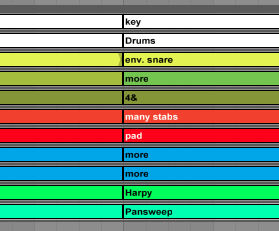Fuzzy Boundaries
Problem:
DAWs tend to automatically structure material in blocks (often called “clips” or “regions”) with clearly defined beginnings and endings. Musical structure is then created by moving the blocks around in time, but the sharp edges between the blocks also create a specific type of musical abruptness which may sound stiff, formulaic, and unrefined.
Most pieces of music divide time into sections, where each section contains a particular type of musical material that contrasts with that in the other sections. Additionally, these sections often exist within a hierarchy of sectional layers, with smaller contrasting subsections chained together to form the larger sections. In the abstract, this hierarchy might look something like this:

DAWs represent this musical structure in a very clear way; blocks of time appear as literal blocks on the screen. But the boundaries of these blocks suggest boundaries in time that are not always good representations of the musical results we want. Here are some ways to make the boundaries between formal sections less abrupt.
Solutions:
Abrupt formal boundaries look like a straight vertical line that cuts through the material in your tracks from top to bottom:

The most straightforward way to deal with this kind of abruptness is to simply make that line become jagged or disappear entirely by:
- extending material from the previous section in one or more (but not all) tracks.
- retracting material from the previous section in one or more (but not all) tracks.
- deleting material on either side of the formal boundary in one or more tracks.
For example, here’s how this formal division might look after applying all of these techniques:

In this example, only the bottom two tracks have been left as they were in the original version. The top two tracks have had material extended beyond the formal boundary, while the next two tracks transition early. The following five tracks all use silence to blur the transition.
Note that this example is not a prescription for a particular set of actions; there’s nothing inherent about this particular pattern of changes that will make sense in all cases. Of course, it’s necessary to adapt what you do to the specifics of the material in your song.
These kinds of “coarse-grained” changes to the length and position of clips can be effective. But sometimes you’ll want to edit the material within the clips themselves. Here are some “fine-grained” ways to think about working with this material:
Anticipation - Drum fills are a common technique used to create a sense of transition from one section to another. But it’s common to hear drum fills that lead out of one section and then end precisely on the downbeat of the next section. Here’s an example of a “typical” drum fill that ends exactly on a downbeat. The energy peaks at the downbeat of bar 3:

This is often musically effective, but it can sometimes feel formulaic and abrupt. Instead, try writing drum fills that anticipate, or end slightly earlier than expected. Reaching the peak of a fill slightly before the downbeat, for example, can create an interesting shift in the flow of musical time. This can be particularly effective if the actual downbeat is de-emphasized somehow, perhaps by stopping the drums entirely until the second beat of the next section, and then re-entering with a “crash” or some other moment that emphasizes the sense of a musical ending. Here’s an example of a drum fill that anticipates the sectional boundary. The energy peaks before the downbeat, followed by silence and a re-entrance on beat 2:

Hesitation - Conversely, try writing a drum fill that lasts longer than expected, extending over the formal boundary between the sections and ending after the rest of the musical material has already changed to the new section. In these cases, it often works well if there’s no sharp emphasis on the end of the fill, and instead the drums of the new section simply take over as seamlessly as possible after the fill. Here’s an example of a drum fill that hesitates beyond the sectional boundary. The energy continues through the downbeat and peaks on beat 2:

Note that you can also apply anticipation and hesitation processes to musical elements besides drums. Try embellishing bass lines using these techniques, or extending (or shortening) sustained chords.